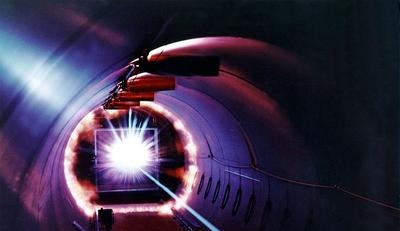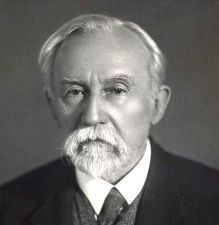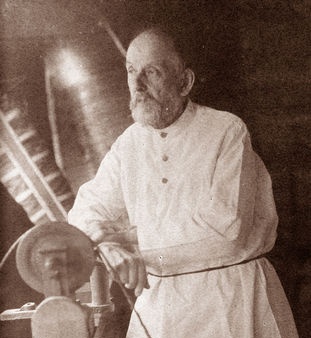|
 As evidenced by the facts, a laser beam can carry enough energy to be able to perform surgical operations, drill diamonds and even heat microscopic quantities of a substance to temperatures of millions of degrees. As evidenced by the facts, a laser beam can carry enough energy to be able to perform surgical operations, drill diamonds and even heat microscopic quantities of a substance to temperatures of millions of degrees.
How much energy can a laser beam carry? It depends on the type of laser, the power of the source supplying it, as well as on the conditions of its operation, which determine the efficiency of using the supplied energy.
And with CW lasers, the input energy is continuously converted into the energy of the radiation emitted by the laser. The power of the beams emitted by such lasers ranges from milliwatts to tens of kilowatts (the same amount as a thousand hundred-watt bulbs emit in the visible range). With these kilowatt beams of light, properly focused, for example by a lens, it is possible to cut a centimeter-thick steel sheet of ship's skin at a speed of about one centimeter per second. Less powerful lasers are used for other purposes that do not require such powerful light beams.
 The most powerful laser seen with one’s own eyes at the Naval Research Institute of the US Navy in Washington, DC, was supposed to emit a beam of about one megawatt (million watts, or thousand kilowatts) in a matter of seconds. This laser, together with auxiliary devices, occupied two rather large laboratory rooms. There is nothing particularly surprising here, since the power of its beam was equal to the power of about fifty engines of middle class passenger cars. The most powerful laser seen with one’s own eyes at the Naval Research Institute of the US Navy in Washington, DC, was supposed to emit a beam of about one megawatt (million watts, or thousand kilowatts) in a matter of seconds. This laser, together with auxiliary devices, occupied two rather large laboratory rooms. There is nothing particularly surprising here, since the power of its beam was equal to the power of about fifty engines of middle class passenger cars.
For many purposes, however, even megawatt beams are weak and require even more powerful beams. For example, a "lunar" laser was supposed to send a beam with a power of several million watts. The light beam after reflection from the Moon returns to the Earth strongly weakened due to absorption and scattering in the Earth's atmosphere, scattering on the surface of the Moon, etc. The sensitivity of the equipment recording reflected light excludes the possibility of using traditional even the strongest light sources for locating the Moon. A sufficiently intense beam of light could only be produced by a laser with a power of several megawatts. To initiate a thermonuclear reaction, an even stronger laser is required - its power should be on the order of at least several million megawatts.
The creation of such a powerful continuous-wave laser is still an unrealistic task. Such a laser would have to have, above all, monstrous dimensions. It would also be a difficult task to provide such a colossus with energy, and it would also be difficult to establish cooling. The efficiency of a laser is typically in the range of a few to ten percent, so that only a relatively small fraction of the energy input to the laser is emitted as radiation. The rest is dissipated, eventually turning into heat, which must be removed from the laser installation, subjecting it to sufficiently intense cooling.
A laser that continuously emitted a beam of one million megawatts would consume the energy generated simultaneously by several thousand medium-sized power plants. During the operation of such a laser, millions of consumers would have to be deprived of the power supply. Perhaps it could still be somehow settled, but how can such a giant be cooled?
However, despite the fact that there is a need for such powerful light beams, there is no need to build such cw lasers.The fact is that in all those applications where there is a need for ultra-high-power laser beams, it does not really matter whether the laser will emit radiation for one thousandth or one millionth of a second. Most often, it is the case that laser radiation is needed only for a short period of time. In short, we are talking about the fact that the laser beam had time to cause the desired effect in the received object before it comes to undesirable processes associated with the energy of laser radiation absorbed by the object. If, for example, when using a laser beam to remove diseased tissue during an operation, the flashes lasted too long, then healthy tissue adjacent to the diseased could also undergo dangerous overheating. If continuous laser radiation is used to drill a hole in a diamond instead of separate flashes, the diamond will overheat, melt, and as a result, a significant part of the diamond will evaporate.
 The above examples indicate the need to use such short laser pulses so that the energy absorbed by the irradiated object does not have time to dissipate due to heat conduction processes. Of course, there are many more such undesirable and often harmful energy dissipation mechanisms. In the general case, we are talking about the fact that the laser beam had time to complete its task before the listed factors interfere with it. This is why, in many devices, laser pulses must be very short, and the expression "very short" sometimes means a nanosecond or even less time. The above examples indicate the need to use such short laser pulses so that the energy absorbed by the irradiated object does not have time to dissipate due to heat conduction processes. Of course, there are many more such undesirable and often harmful energy dissipation mechanisms. In the general case, we are talking about the fact that the laser beam had time to complete its task before the listed factors interfere with it. This is why, in many devices, laser pulses must be very short, and the expression "very short" sometimes means a nanosecond or even less time.
Now it becomes clear to us, dictated by the need, a simple idea of saving energy, on the basis of which it is possible to obtain beams of gigantic power at relatively low energy costs. Instead of producing, say, one joule of energy in the form of radiation (this is a very small amount) for a second, or emitting a beam of one watt (1 W = 1 J / s), it simply follows the same amount of energy (one joule ) emit faster as a relatively short pulse. The shorter the pulse, the higher the beam power. If, for example, a burst of radiation lasts one millisecond (one microsecond, one nanosecond), then the beam will have a power 1000 times higher (relative).
Obviously, with an energy contribution 1000 times greater (1 kJ instead of 1 J), it will turn out (in each of the above cases) that the beam is 1000 times more powerful. If the time of emission (emission) would amount to a value of the order of one nanosecond, then in this case a beam with a power of one terawatt would be obtained. Focused, for example, with a lens on the surface of the body into a spot of about 0.1 mm in diameter, such a beam would give in focus an unimaginable value of intensity - 10 to the 20th power of W / m2! (For comparison, the light intensity of a 100-watt light bulb at a distance of 1 m from it is on the order of a few tenths of a watt per square meter.)
There remains one question, seemingly innocent at first glance: how to reduce the laser radiation time at a given total beam energy? Such a task is a complex problem of both physical and technical nature. We will not go into such subtleties here, because for our story the question of receiving a short pulse is too special. In any case, today the situation is as follows: the time of light emission by a pulsed laser without any additional devices that would force the laser to emit light faster is on the order of a few microseconds (or a tenth of one thousandth of a second).
 The use of additional devices, the operation of which is based on some physical phenomena, will help reduce this time to values on the order of a picosecond. Thanks to this, today it is possible to obtain giant laser pulses, the maximum power of which can even reach several hundred terawatts.Of course, such powerful beams are needed only in special devices (for example, to initiate a thermonuclear reaction). In many other cases, pulses of much lower power are used. The use of additional devices, the operation of which is based on some physical phenomena, will help reduce this time to values on the order of a picosecond. Thanks to this, today it is possible to obtain giant laser pulses, the maximum power of which can even reach several hundred terawatts.Of course, such powerful beams are needed only in special devices (for example, to initiate a thermonuclear reaction). In many other cases, pulses of much lower power are used.
Now let's ask an important question: is it possible to obtain such intense light beams cheaper and easier, namely with the help of traditional high-power lamps? This refers to both lamps operating in a continuous mode (for example, lamps of aircraft reflectors or cinema cameras), and flash lamps (for example, flashlights used in photography).
The answer depends on what kind of beams we would like to obtain, or, in other words, what power and what kind of divergence we are talking about. If we are indifferent to the beam divergence, then traditional lamps are able to compete with lasers only up to a certain limit. This limit lies, in any case, well below one terawatt. Above this level, the laser has no competitors.
Of course, the less diverging and more powerful beams we want to get, the lower the boundary will lie, above which we will have to abandon traditional light sources and turn to lasers. As already mentioned, classical light sources would not be able to satisfy the high accuracy requirements that were imposed on a light source when measuring the distance from the Earth to the Moon. In this experiment, a pulsed laser had to be used.
Gavrilova N.V.
|
 As evidenced by the facts, a laser beam can carry enough energy to be able to perform surgical operations, drill diamonds and even heat microscopic quantities of a substance to temperatures of millions of degrees.
As evidenced by the facts, a laser beam can carry enough energy to be able to perform surgical operations, drill diamonds and even heat microscopic quantities of a substance to temperatures of millions of degrees. The most powerful laser seen with one’s own eyes at the Naval Research Institute of the US Navy in Washington, DC, was supposed to emit a beam of about one megawatt (million watts, or thousand kilowatts) in a matter of seconds. This laser, together with auxiliary devices, occupied two rather large laboratory rooms. There is nothing particularly surprising here, since the power of its beam was equal to the power of about fifty engines of middle class passenger cars.
The most powerful laser seen with one’s own eyes at the Naval Research Institute of the US Navy in Washington, DC, was supposed to emit a beam of about one megawatt (million watts, or thousand kilowatts) in a matter of seconds. This laser, together with auxiliary devices, occupied two rather large laboratory rooms. There is nothing particularly surprising here, since the power of its beam was equal to the power of about fifty engines of middle class passenger cars. The above examples indicate the need to use such short laser pulses so that the energy absorbed by the irradiated object does not have time to dissipate due to heat conduction processes. Of course, there are many more such undesirable and often harmful energy dissipation mechanisms. In the general case, we are talking about the fact that the laser beam had time to complete its task before the listed factors interfere with it. This is why, in many devices, laser pulses must be very short, and the expression "very short" sometimes means a nanosecond or even less time.
The above examples indicate the need to use such short laser pulses so that the energy absorbed by the irradiated object does not have time to dissipate due to heat conduction processes. Of course, there are many more such undesirable and often harmful energy dissipation mechanisms. In the general case, we are talking about the fact that the laser beam had time to complete its task before the listed factors interfere with it. This is why, in many devices, laser pulses must be very short, and the expression "very short" sometimes means a nanosecond or even less time.









